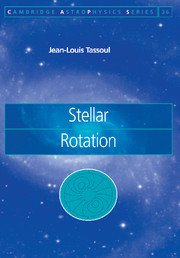7 - The late-type stars
Published online by Cambridge University Press: 15 August 2009
Summary
Introduction
On the main sequence, it has long been known that large mean rotational velocities are common among the early-type stars and that these velocities decline steeply in the F-star region, from 150 km s−1 to less than 10 km s−1 in the cooler stars (see Figure 1.6). As was shown in Section 6.3.2, the observed projected velocities indicate that the mean value of the total angular momentum 〈J〉 closely follows the simple power law 〈J〉 α M2 for stars earlier than spectral type F0, which corresponds to about 1.5M⊙ (see Figure 6.7). The difficulty is not to account for such a relation, which probably reflects the initial distribution of angular momentum, but to explain why it does not apply throughout the main sequence. It has been suggested that the break in the mean rotational velocities beginning at about spectral type F0 might be due to the systematic occurrence of planets around the low-mass stars (M ≲ 1.5M⊙), with most of the initial angular momentum being then transferred to the planets. Although this explanation has retained its attractiveness well into the 1960s, there is now ample evidence that it is not the most likely cause of the remarkable decline of rotation in the F-star region along the main sequence. Indeed, following Schatzman's (1962) original suggestion, there is now widespread agreement that this break in the rotation curve can be attributed to angular momentum loss through magnetized winds and/or sporadic mass ejections from stars with deep surface convection zones.
- Type
- Chapter
- Information
- Stellar Rotation , pp. 190 - 206Publisher: Cambridge University PressPrint publication year: 2000



